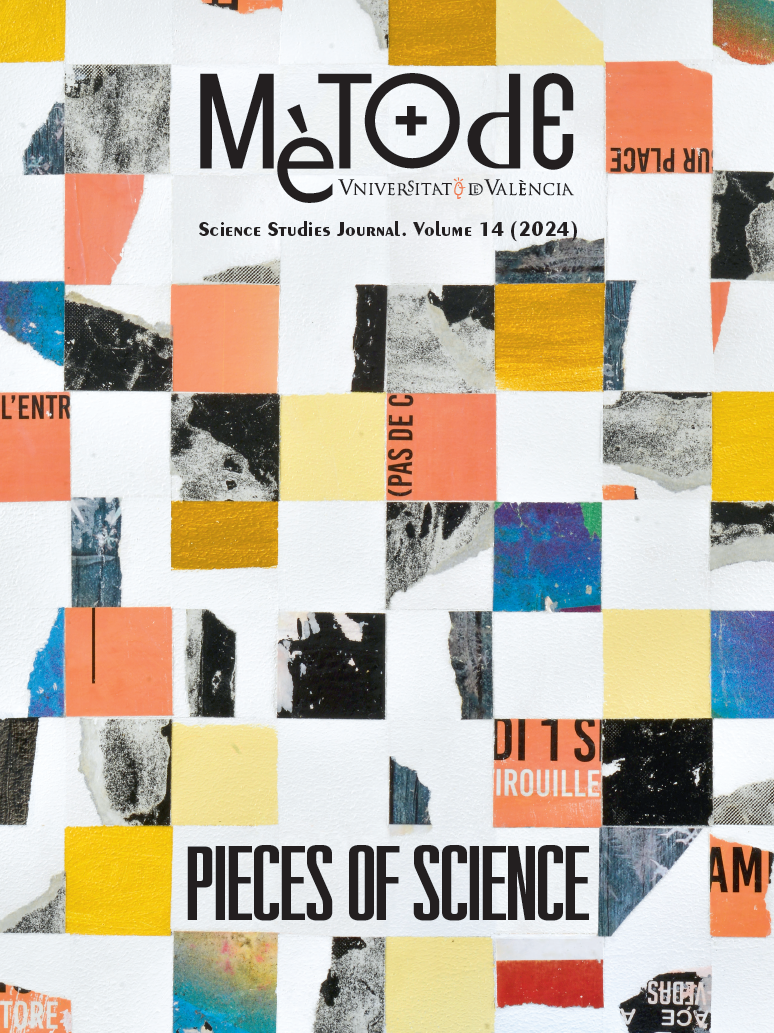Scientific photography and astronomy: Technology applied to understanding the universe
DOI:
https://doi.org/10.7203/metode.14.24625Keywords:
astronomy, digital photography, light, technology, universe Abstract
Abstract
In 1925, Edwin Hubble took the first step towards increasing the size of the known universe by several orders of magnitude using the precarious photographic methods available at the time: glass plates and photosensitive emulsions. Analysing periodic variations in the brightness of certain stars (Cepheids) through photographs, Hubble was able to show that the distance between Andromeda and the Earth was much greater than previously thought. Thus, Andromeda, previously thought to be a nebula, had to be a galaxy different from our own. Suddenly, the estimated size of the universe went from a few hundred thousand light years to a few billion light years. Since then, the synergy between photographic technology and astronomy has continued to grow.
 Downloads
Downloads
 References
References
Benneke, B., Wong, I., Piaulet, C., Knutson, H. A., Lothringer, J., Morley, C. V, Crossfield, I. J. M., Gao, P., Greene, T. P., Dressing, C., Dragomir, D., Howard, A. W., McCullough, P. R., Kempton, E. M. R., Fortney, J., & Fraine, J. (2019). Water vapor and clouds on the habitable-zone sub-Neptune exoplanet K2-18b. The Astrophysical Journal Letters, 887(1), L14. https://doi.org/10.3847/2041-8213/ab59dc
Böker, T., Arribas, S., Lützgendorf, N., Alves de Oliveira, C., Beck, T. L., Birkmann, S., Bunker, A. J., Charlot, S., de Marchi, G., Ferruit, P., Giardino, G., Jakobsen, P., Kumari, N., López-Caniego, M., Maiolino, R., Manjavacas, E., Marston, A., Moseley, S. H., Muzerolle, J., … Zeidler, P. (2022). The near-infrared spectrograph (NIRSpec) on the James Webb Space Telescope. III. Integral-field spectroscopy. Astronomy & Astrophysics, 661, A82. https://doi.org/10.1051/0004-6361/202142589
Bryson, S., Kunimoto, M., Kopparapu, R. K., Coughlin, J. L., Borucki, W. J., Koch, D., Aguirre, V. S., Allen, C., Barentsen, G., Batalha, N. M., Berger, T., Boss, A., Buchhave, L. A., Burke, C. J., Caldwell, D. A., Campbell, J. R., Catanzarite, J., Chandrasekaran, H., Chaplin, W. J., … Zamudio, K. A. (2021). The occurrence of rocky habitable-zone planets around solar-like stars from Kepler data. The Astronomical Journal, 161(1), 36. https://doi.org/10.3847/1538-3881/abc418
Bunn, E. F., & Hogg, D. W. (2009). The kinematic origin of the cosmological redshift. American Journal of Physics, 77(8), 688–694. https://doi.org/10.1119/1.3129103
Cassinello Espinosa, A. (2019). La medida del cielo: Momentos estelares en las ciencias del cosmos. Escolar y Mayo Editores S. L.
Gardner, J. P., Mather, J. C., Clampin, M., Doyon, R., Greenhouse, M. A., Hammel, H. B., Hutchings, J. B., Jakobsen, P., Lilly, S. J., Long, K. S., Lunine, J. I., Mccaugherean, M. J., Mountain, M., Nella, J., Rieke, G. H., Rieke, M. J., Rix, H., Smith, E. P., Sonneborn, G., … Wright, G. S. (2006). The James Webb space telescope. Space Science Reviews, 123(4), 485–606. https://doi.org/10.1007/s11214-006-8315-7
Harrison, E. (1993). The redshift-distance and velocity-distance laws. The Astrophysical Journal, 403, 28–31.
Henden, A. A., Welch, D. L., Terrell, D., & Levine, S. E. (2009). The AAVSO photometric all-sky survey (APASS). American Astronomical Society Meeting Abstracts, 214, 402–407.
Hubble, E. (1929). A relation between distance and radial velocity among extra-galactic nebulae. Proceedings of the National Academy of Sciences, 15(3), 168–173. https://doi.org/10.1073/pnas.15.3.168
Hubble, E., & Humason, M. L. (1931). The velocity-distance relation among extra-galactic nebulae. The Astrophysical Journal, 74, 43–80. https://doi.org/10.1086/143323
Huggins, W., & Miller, W. A. (1864). On the spectra of some fixed stars. Philosophical Transactions of the Royal Society of London, 154, 413–445. https://doi.org/10.1098/rstl.1864.0012
Leavitt, H. S., & Pickering, E. C. (1912). Periods of 25 variable stars in the Small Magellanic Cloud. Harvard College Observatory Circular, 173, 1–3.
Libby-Roberts, J. E., Berta-Thompson, Z. K., Désert, J.-M., Masuda, K., Morley, C. V., Lopez, E. D., Deck, K. M., Fabrycky, D., Fortney, J. J., Line, M. R., Sanchis-Ojeda, R., & Winn, J. N. (2020). The featureless transmission spectra of two super-puff planets. The Astronomical Journal, 159(2), 57. https://doi.org/10.3847/1538-3881/ab5d36
Mayor, M., & Queloz, D. (1995). A Jupiter-mass companion to a solar-type star. Nature, 378(6555), 355–359. https://doi.org/10.1038/378355a0
Petigura, E. A., Howard, A. W., & Marcy, G. W. (2013). Prevalence of Earth-size planets orbiting Sun-like stars. Proceedings of the National Academy of Sciences of the United States of America, 110(48), 19273–19278. https://doi.org/10.1073/pnas.1319909110
Rossiter, M. W. (1980). “Women’s work” in science, 1880-1910. ISIS, 71(3), 381–398. https://doi.org/10.1086/352540
Shapley, H., & Curtis, H. D. (1921). The scale of the universe. Bulletin of the National Research Council, 2(11), 171–217. https://archive.org/details/scaleofuniverse00shap
Slipher, V. M. (1915). Spectrographic observations of nebulae. Popular Astronomy, 23, 21–24.
Taton, R., & Curtis, W. (1995). Planetary astronomy from the Renaissance to the rise of Astrophysics: Part B: The Eighteenth and Nineteenth centuries. Cambridge University Press.
Downloads
Published
How to Cite
-
Abstract984
-
PDF156
Issue
Section
License
Copyright (c) 2023 CC BY-NC-ND 4.0

This work is licensed under a Creative Commons Attribution-NonCommercial-NoDerivatives 4.0 International License.
![]()
All the documents in the OJS platform are open access and property of their respective authors.
Authors publishing in the journal agree to the following terms:
- Authors keep the rights and guarantee Metode Science Studies Journal the right to be the first publication of the document, licensed under a Creative Commons Attribution-NonCommercial-NoDerivatives 4.0 International License that allows others to share the work with an acknowledgement of authorship and publication in the journal.
- Authors are allowed and encouraged to spread their work through electronic means using personal or institutional websites (institutional open archives, personal websites or professional and academic networks profiles) once the text has been published.





